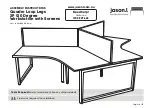
Combination 860
53
Medium-frequency stimulation
Interferential therapy employs medium frequency currents used in 2 or 4-
pole configurations to produce a low frequency stimulation effect.
Prior to the introduction of interferential therapy in the mid 1950s, low
frequency stimulation was used for pain relief, muscle re-education etc.
These currents, however, have the disadvantage that normal human skin
has a relatively high impedance at such frequencies. In order to overcome
the skin impedance a larger voltage has to be used to achieve the desired
current, resulting in a more uncomfortable treatment for the patient. In
addition, the penetration depth of these currents is poor and in part is
limited by the discomfort to the patient.
Interferential therapy overcomes the problem of skin impedance. At 50 Hz
(faradic current) the impedance for a 100 cm
2
of skin is approximately 3000
ohms. At 4000 Hz (medium frequency) the skin impedance of the same
area is around 50 ohms. This means that a much lower voltage signal can
be used to produce the desired current, resulting in less skin sensation and
a more comfortable treatment. This medium frequency is, however, well
outside of the normal biological frequency range (0.1 to 250 Hz). In order to
produce the required stimulation, two medium frequencies are used. A
constant frequency of, say, 4000 Hz is applied to one pair of electrodes and
a slightly different frequency of say 3900 Hz is applied to the other pair.
These two frequencies 'interfere' to produce an amplitude modulated
medium frequency (beat frequency) in the tissue. The tissue responds to
the cyclic rise and fall in the current intensity. It is the amplitude modulation
frequency (AMF) that is within the normal biological frequency range and
not the medium frequency (carrier).
Russian stimulation was developed by Dr Y Kotz, and uses 2.5 kHz
sinewaves pulse at a low frequency, typically 30 to 80 Hz, to produce
comfortable muscle contraction. It is similar to a surged, 2-pole
interferential waveform.
Transcutaneous electrical nerve stimulation (TENS) refers to the
application of low-intensity, short-duration pulses for the purpose of
relieving pain. The Combination 860 provides two channels of asymmetric,
symmetric or sequential output with a wide range of pulse widths and
repetition rates.
Summary of Contents for 125
Page 1: ...User Manual PRIMO COMBINATION 860 Model 125 ...
Page 2: ...Combination 860 2 ...
Page 77: ...Combination 860 77 ...
















































